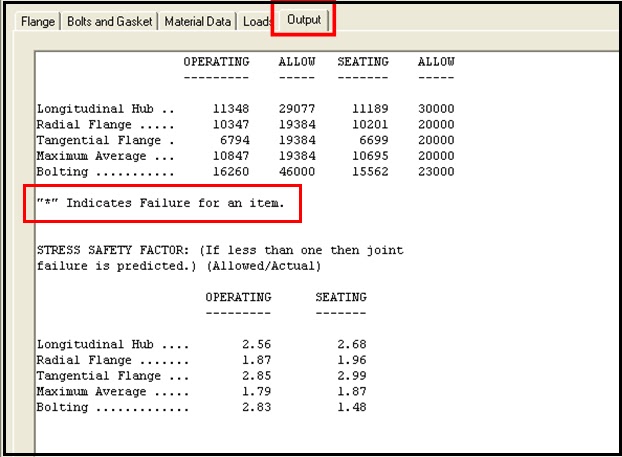My last two articles on flange leakage explains the basic theory behind flange leakage checking and methods for performing flange leakage checking using pressure equivalent method. In this article I will explain the steps taken to perform flange leakage check using Caesar II by ASME Sec VIII method. Normally this method is performed when the analysis in pressure equivalent method shows failure in Caesar II. Pressure equivalent method being too conservative does not provide us the actual realistic results. Hence this method is widely accepted where pressure equivalent method shows a failure. The steps involved are mentioned below:
- After performing static analysis click the “Analysis” and then click “Flanges” in CAESAR II as shown below.
- Provide a file name and select the proper Flange Type in the section as mentioned in the PMS. Input the flange parameters as shown below:
- Press the key “Ctrl+F” to select the concerning Size and Rating. Few data will automatically filled from Caesar II database. However it is good practise to confirm the data from governing code.
- Flange Class is the flange pressure rating and is required for checking P-T Rating of Equivalent Pressure.
- Flange Grade: Select Material Group No. as per ASME B 16.5 Table 1A list of material specification. Following table can be used as reference:
- Refer to the applicable flange code ASME 16.5 or ASME B 16.47 and update automatically filled flange data. Take special care while inputing for ‘Small End Hub Thickness’& ‘Large End Hub Thickness’. ‘Small End Hub Thickness ’ must be equal to the Pipe Thickness. Large End Hub Thickness must be equal to (X-B) where X is Hub Diameter and B Flange ID.
- Enter hub Length h=(Y-tf) where Y is length through Hub and tf is flange thickness.
- Now it is the turn to enter the Bolts and gasket parameters. Take parameters from ASME B 16.20 or ASME B 16.21 as shown below:
- Check Bolt Circle Diameter, Number of Bolts and Bolt Diameter, suggested by CAESAR II in reference with ASME B 16.47, 16.5.
- Correctly input for Gasket information in conjunction with ASME B 16.20 or 16.21 as applicable.
For Effective Gasket Modulus, press Shift+? Key and then follow “High End” in Help statement. Leak Pressure Ratio m, Gasket Seating Stress y shall be in accordance with ASME SECTION VIII Div.1. Values for Caesar II help can be taken by pressing Shift+?.
- For Nubbin Width in the right side, Leave blank for Welding Neck Type and input Ring joint width as per the ring no. as described on ASME B 16.20 Table 3 TYPE R RING GASKET DIMENSIONS AND TOLERANCES for ring type joint.
- Facing Sketch/ Facing Column can be inputted as follows mentioned below:
- Now input the material data as shown below:
- Select the material of Flange and bolt, and Input design temperature.
- Flange Allowable & Bolt Allowable at design and ambient temp can be taken from CAESAR II database for particular flange and bolt material.
Flange Modulus of Elasticity shall be taken from table C-6 of ASME B-31.3.which is given in millions of psi convert it to consistent unit
- Use 1.0 for Flange Allowable Stress Multiplier and 2.0 for Bolt Allowable Stress Multiplier. Use project specific data if available.
- Now Input Design Pressure, Axial Force, Bending Moment from Static analysis of the Caesar file as shown below:
- Now run the analysis to study the output results. Normally If safety Factor is less than one then joint failure is predicted and in output this is shown by a * mark.
- If result shows failure then try to reduce the bending moment or axial force and reanalyse. If that is not possible check if the flange rating can be increased.
If you like this post share with your friend and Provide your input in comments section











You could help us. Your post's flanges and type are amazing. Thanks for enlightening us on this topic. Here's an 316L stainless steel strips.
ReplyDeleteLearning about this amazing growth brought joy. We appreciate your knowledge. Stainless Steel SMO 254 Sheet Plate is suggested. Your kindness is appreciated.
ReplyDelete